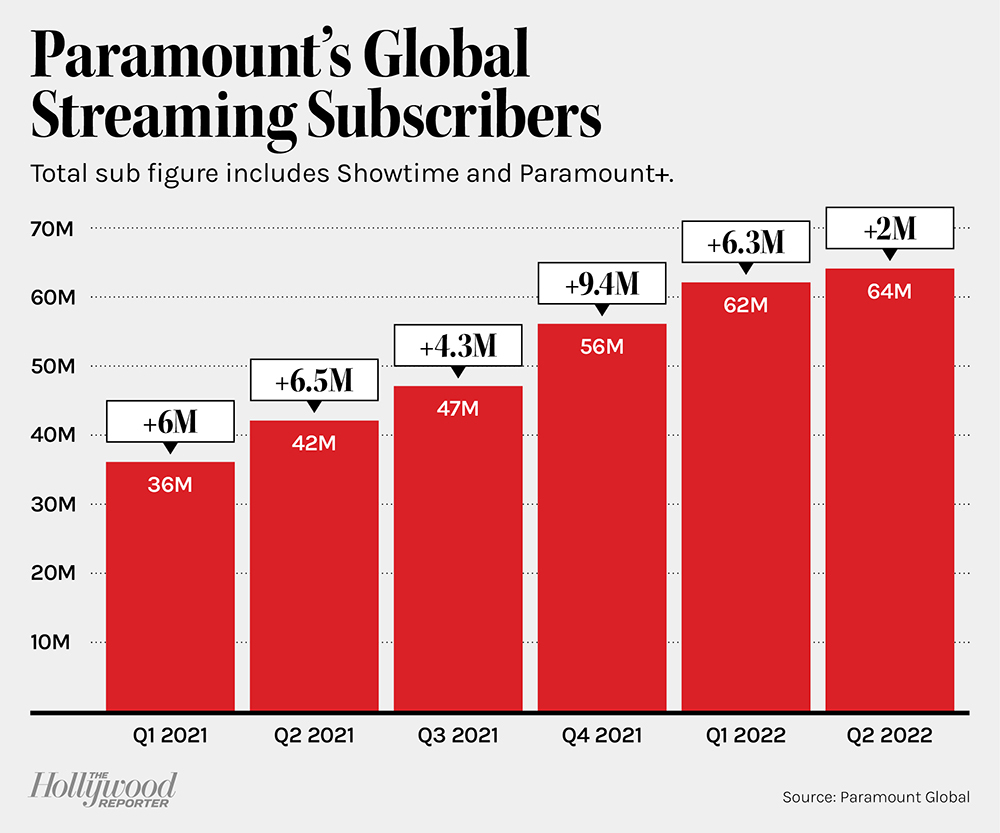
A “contrarian” stock upgrade, a stock price cut and a warning about “new worries” were among Wall Street analysts’ initial reactions to Paramount Global’s second-quarter earnings update on Thursday. The company reached “nearly 64 million” streaming subscribers worldwide as of the end of June, up from more than 62 million as of the end of March.
CFRA Research analyst Kenneth Leon raised his rating on the Hollywood conglomerate’s stock from “hold” to “buy” and raised his price target by $3 to $33, even though several peers have recently turned more cautious on Paramount due to concerns about its advertising revenue exposure amid gathering economic clouds and questions about whether it can make its growing streaming business profitable in the near- to mid-term.
“We have a contrarian investment view, as we think Paramount can execute and gain market share across all businesses,” Leon wrote, saying his new stock price target was “in line with both five-year historic average and peer average” earnings multiples. But he lowered his earnings per share estimates for 2022 by 15 cents to $2.65 and for 2023 by 5 cents to $2.25, noting that this was above the Wall Street consensus.
In contrast, Barclays analyst David Joyce, who has an “underweight” rating and $20 stock price target on Paramount, summarized his take on the financial update this way: “Outlook gets weaker on advertising, affiliate and streaming losses.”
That was a reference to comments from Paramount CFO Naveen Chopra on the earnings conference call about the streaming business that drew attention. The CFO reiterated the company’s goal of getting to spending $6 billion on streaming content in 2024, with streaming losses to peak in 2023, but signaled that 2022 streaming losses would hit around $1.8 billion rather than the originally targeted $1.5 billion. With streaming revenue and subscriber count growing, “our content investment is working,” Chopra argued.
Joyce’s take on this was: “quarter better, guidance lower.” After all, earnings for the second quarter exceeded expectations, “however, the company’s guidance on TV earnings before interest, taxes, depreciation and amortization (EBITDA) is more modest than prior guide, and losses in streaming are higher than prior guide,” he emphasized.
Joyce then dug deeper into the first of those two issues. “On the TV media side, while the 6 percent decline in advertising in the [second] quarter was partly on account of tough comps, the macro environment is already resulting in lowered expectations for growth across the advertising ecosystem,” he wrote. “Third-quarter advertising is likely to be flat to down, while the fourth quarter will likely benefit to some extent from political and upfronts but may be up low single digits.”
In terms of streaming financials, Joyce said: “The loss in cash flow on account of streaming has been a lot steeper than the loss in earnings with annualized cash flows dropping from $2.5 billion in 2020 (and $3.5 billion in 2018) to an expected around $500 million this year. Unless streaming economics change sharply over the next year or the company scales down its ambitions in streaming, cash flow next year may be close to breakeven at best.”
The Barclays analyst summarized his take on Paramount’s streaming business by arguing that it has an “unclear strategic objective.” Concluded Joyce: “While the company has invested significant resources into streaming, the economics of this business remain difficult to sustain in our view.”
Guggenheim’s Michael Morris maintained his “buy” rating on Paramount, but cut his price target by $4 to $31 amid the bigger-than-expected 2022 streaming losses. He summed up his stance in the title of his report: “Top Gun Boosts Second-Quarter Beat; Bigger Direct-to-Consumer Drag Drives Second-Half, 2023 Estimate Cuts.”
Meanwhile, Cowen analyst Doug Creutz, who has a “market perform” rating and $33 price target on Paramount shares, focused his report’s title on the fact that the company’s second-quarter earnings beat Wall Street consensus expectations: “Q2 Results Beat Consensus on Top Gun Performance.”
Creutz did also note though: “Top Gun helps, but not quite as much as we had expected.” After all, the firm’s adjusted operating income before depreciation and amortization (AOIBDA) of $963 million (-22 percent year-over-year) also missed our estimate of $1.06 billion, but beat on consensus (of) $867 million.” Creutz explained that he had estimated second-quarter “theatrical performance would add around $200 million to AOIBDA, but the benefit appears to have been closer to $100 million.”
On the downside, the Cowen expert also highlighted that streaming user results came in below his forecasts. “Global streaming subs increased 1.3 million quarter-over-quarter to 63.7 million, short of our 64.9 million estimate,” he wrote. “Results included the removal of 3.9 million Russian subs, which we had baked into our estimates. Showtime and other OTT services lost around 2.4 million subs, while Paramount+ added 4.9 million subs. Global Pluto monthly active users increased 2.1 million quarter-over-quarter to 69.6 million, below our 71.5 million estimate.”
Wells Fargo analyst Steven Cahall, in a first reaction to Paramount’s latest quarterly results, noted that “total company advertising was $2.545 billion, in line with us,” but 3 percent below Wall Street consensus estimates. “Free cash flow was $81 million and compared to consensus of $85 million.” He summarized his takeaways in the headline of his report: “Good Paramount+ Results, but Ads and Free Cash Flow Will Create New Worries.”
Cahall expanded on this by explaining: “Net/net we view this as an in-line [report] with puts and takes. Paramount+ continues to make progress with the leading domestic net adds arguably the bright spot. Pluto engagement seems solid based on monthly active users, but we know Connected TV/Free Ad-supported Streaming TV (FAST) services pricing is under pressure from macro buying shifts.”
Investors overall seemed to have liked what they read in Paramount’s earnings report and heard on management’s conference call though. As of 2:45 p.m. ET, the stock was up 1.1 percent at $25.32.
